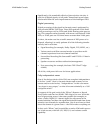
1-2
Getting Started Mark Levinson
Special Design Features
Modular Design
As seen from the rear panel, perhaps the most obvious characteris-
tic of the Nº40 is its extraordinary modularity. Both the audio
processor and the video processor are built on “card cage” designs
that maximize hardware flexibility now and in the future. While
more costly than an “everything on one board” approach, the
extensive modularity of the Nº40's design is the best and most
logical response to the rapidly-changing world of high performance
audio and video.
The state of these arts (audio and video) are moving fast, and while
we will have legacy products like traditional analog VCRs for years
to come, we must also be prepared to accommodate new products
and signal formats that we cannot predict today. With the Nº40, we
have done our best to ensure that our options are kept open for the
future.
Extraordinary
Flexibility
Even today, however, we have a truly remarkable assortment of
source components that can be brought into a sophisticated home
entertainment system. Hence the need for equally remarkable input
and output capabilities, and a clear, powerful and flexible user
interface. Also needed are innovative approaches to simplifying the
experience of an admittedly complex system; and a variety of tools
to facilitate custom-installation applications that may require the
Nº40 to control other products, or for the Nº40 to be controlled by
other products.
Input/Output flexibility
The Nº40 is modular, and can accommodate many possible config-
urations. But in its standard configuration, we have tried to meet
the needs of perhaps 95% of the prospective owners of such a prod-
uct. With
• 7 analog audio inputs (one of which is balanced)
• 13 digital audio inputs (6 RCA, 4 Toslink™, 2 AES/EBU, 1 BNC)
• 12 analog video inputs (3 composite, 6 S-video, 3 component)
• 8 main zone audio outputs (which can be configured in many
ways to suit different systems)
• 3 main zone video outputs (composite, S-video, Component/
RGBSc)
• 1 monitor video output
• 2 “RZone” output paths (assignable Remote or Record zones)
that each include composite and S-video outputs, two pairs of


















